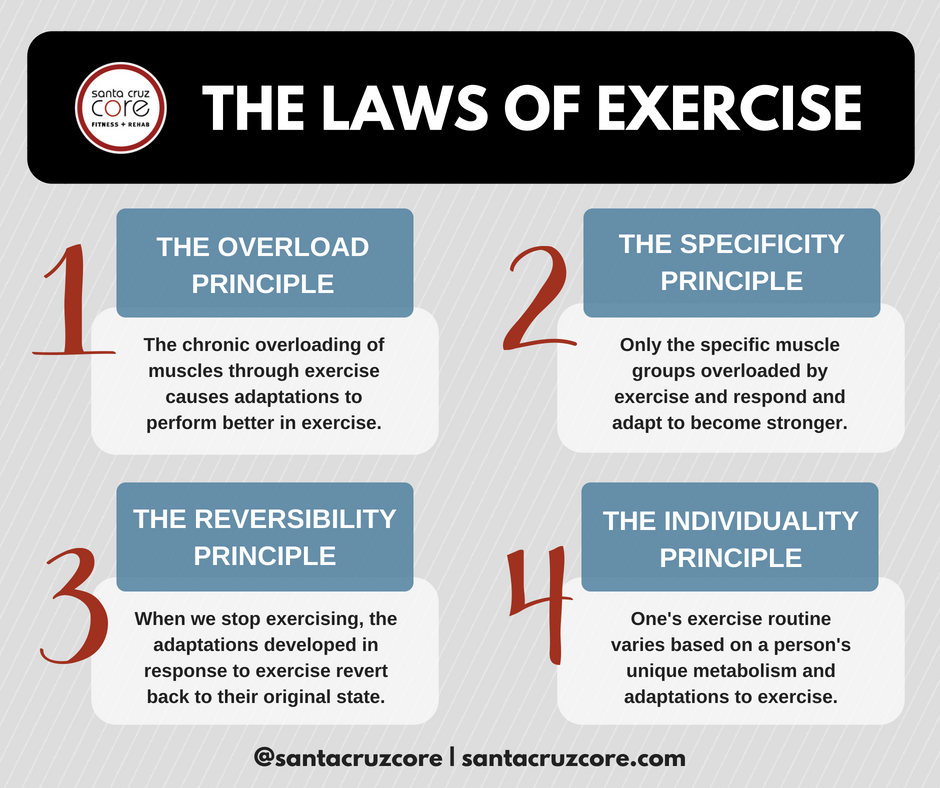
Engaging in a regular exercise routine benefits overall health.
But many of us engage in regular exercise with specific goals in mind including weight-loss, muscle growth, and athletic performance. Regardless of fitness goals, it is always good to learn about the principles of exercise and how these can help us reach those goals.
Overload Principle:
The overload principle states that the chronic overloading (exhausting) of muscles through exercise leads to them adapting to better perform that exercise. The muscles adapt by growing in size (muscle hypertrophy) and by changing their muscle fiber composition.
This principle is easily experienced by engaging in routine exercise. When one repeats the same exercises, like push-ups or jumping jacks, they become easier over time. This because the repeated exercises represent stimuli to which the body adapts.
Specificity Principle:
This principle states that only the specific muscle groups overloaded by exercise will respond and adapt. If you only exercise your arms by lifting weights, then only your arms and muscles recruited to lift the weights will adapt and get stronger.
This principle helps explain some of the physical differences between athletes of different sports. Soccer players, for example, have strong legs that have adapted to sustain for long periods of running. While football players have large muscle groups adapted for explosive movements like tackling down an opponent.
Many bodybuilders work on exercising only certain muscle groups per day based on the specificity principle. This allows them to switch between muscle groups of focus throughout the week and achieve specific fitness goals (like bigger arms, bigger legs, or a six-pack).
Reversibility Principle:
When we stop exercising, the adaptations developed in response to exercise revert back to their original state. Any muscle growth that may have resulted from repeated strength training, for example, will decrease if the exercise is not continued.
How fast these training adaptations disappear may depend on how intense the exercise training was. It may also depend on the individual’s daily activity levels. If there is a big difference between the two, then the loss of training adaptations will be faster and more noticeable.
Athletes who are injured and cannot continue training as a result of an injury may slow the loss in muscle tone. They can do this through nutrition counseling and the electrical stimulation of muscles (to induce muscle contraction).
Individuality Principle:
Everyone’s body is different and adapts differently to exercise. The exercise routine from a friend may not give you the same results and vice-versa. This principle acknowledges the uniqueness of each person’s metabolism and adaptations to exercise.
Genetics, lifestyle, dietary supplementation, stress levels, and recovery time may all have an effect on this principle.
It is important to get to know one’s own body and how it responds to different forms of exercise. This will help push training adaptations in the direction of fitness goals by practicing the exercises that give the best results.
At Santa Cruz CORE we specialize in reaching personal fitness goals through guided exercise, diet, and lifestyle changes. For more tips on how to reach your specific fitness goals try out our personal training, semi-private training, and corrective exercise programs!
References:
“Science of Exercise.” Coursera, University of Colorado Boulder, www.coursera.org/learn/science-exercise.








